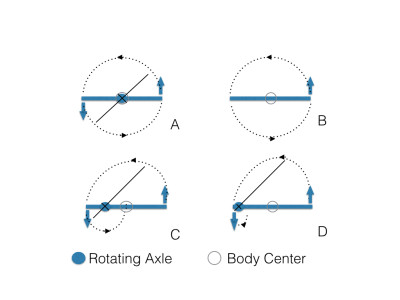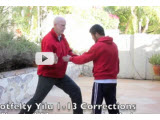Let’s do an experiment. Find a stick about a foot long. Put a mark on the center point. Use fingers of one hand to hold one end of the stick in horizontal position. Now, try to rotate the stick horizontally, and make the center point of the stick as the rotation center, and try your best to keep the center point not moving around. Soon you’ll find out that is not a simple task even though it sounds simple. This is not because you don’t have enough strength in your hand/arm to hold steady of the stick. It’s because you only control one end of the stick.
Now, let’s use the other hand to hold the other end of the stick. Use one hand to push the stick forward, the other hand to pull the stick back, with equal amount of the strength and move equal amount of the distance. You will find out that you can quite easily control the stick. You can rotate the stick on the center point, and keep the center point quite stable. The more power you apply on the stick’s two ends, the more stable the stick will be, and the more clear the center of the stick as the pivot point.
Furthermore, if we move one end of the stick more than the other end, the stick’s pivot point can be shifted toward the end which moves less. Eventually one end of the stick seems not moving at all, while the other end rotate around it. In the following figure, (B) illustrates one hand controlling the stick, while (A), (C) and (D) illustrate two hands controlling the stick. In (A), the distances created by pushing and pulling are the same. In (C) and (D), one end moves more than the other end.

The stick experiment is easy to do. The results are obvious and convincing. With one hand only, it’s really hard to control the stick. You might get the stick to rotate around a pivot point. But it’s not stable. It gives you a false center point. With two hands working together, you can rotate the stick with a clear pivot point, which is also stable. We can now extend this conclusion to the rotation of Kua. Both “Kua” need to be actively engaged in rotations.
It seems obvious that we move two kuas always simultaneously. When one kua moves, the other will move along with, because two kuas are on the pelvic girdle, they are connected as two ends of a stick. What I have been missing previously was the consciousness of actively moving both kuas. I thought when I rotated front kua forward, if I had a center and the rotation was made around that center, the rear kua would automatically rotate back. I was puzzled when Master Chen told me that I tossed or moved while I thought I was not tossing because I had a center, I was not moving because I had a pivot point or vertical axle. Now I understand what I was doing wrong before. I was doing the rotation as in the case of rotating the stick just by one hand. It just gives you a false and weak pivot center. That’s why I tossed and moved even though I thought I didn’t. So, when you rotate, you need to have both kuas engaged.
In foundations and most of Yilu forms, both kuas rotate evenly so a central axle is created. As in Figure (A). In Cannon Fist, two kuas are not evenly rotating. One moves more than the other, which shifts the rotating axle off center line, as in (C) and (D). When we say fix one kua not moving, it still rotates but in a smallest amount so it could not be seen.
(For a side note, how do we rotate both Kuas? The power has to be generated from knees.)



{ 7 comments… read them below or add one }
Thanks for this post Pingwei, this is very helpful. There is also video called “horse stance,” which describes the action as pedalling a bicycle.
Yes, that’s how we power our kuas.
That’s very interesting, thank you Pingwei. Lots of really important points.
Thanks, Bruce.
Hi Ping Wei! Great article, really has my wheels turning ;). Quick question, you comment at the end that the power must be generated by the knees, can you elaborate on this topic by chance? I find after training for a few years now the connection in foot and kua rotations I’m slowly seeing, but the knees are still very elusive to me. I think I understand one knee up, one knee down, but cannot generate power yet. Any help would be greatly appreciated:).
Hi, Rick. I posted an article about energy pathway last year. http://practicalmethod.com/2015/12/energy-pathway-from-foot-to-hand/
The diagram illustrated the connection from foot to hand. It really could be viewed and applied in sections. As of how the knee works, look for relations among foot, knee and kua.
Hope this might give you a little help.
Thank you!